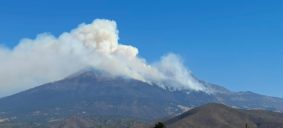
A recent major forest fire on Volcán Sierra Negra, located in the Mexican federal National Park of Pico de Orizaba, has negatively impacted the current operations of the Large Millimeter Telescope (LMT) and the High Altitude Water Cherenkov Array (HAWC).
The following note briefly summarizes the circumstances and impact of a recent major forest fire on Volcán Sierra Negra, the site of the Large Millimeter Telescope (LMT) and the High Altitude Water Cherenkov Array (HAWC), located in the Mexican federal National Park of Pico de Orizaba.
On the morning of Monday 20th February 2023 a fire started (from unknown causes) on the south-facing slopes of Sierra Negra at an altitude between 3500-4000 meters, and quickly spread eastwards and northwards towards LMT and HAWC infrastructure, including the access road to both observatories. Upon receiving notification of the on-set of the fire at lower altitudes, the LMT and HAWC staff working at both telescope facilities immediately evacuated and safely descended to areas below the fire. The forest fire continued for 5 days before finally burning itself out and coming under-control on Friday 24th February.
The LMT site is situated on the summit of Sierra Negra at an altitude of 4600 meters, approximately 500 meters above the tree-line and vegetation. At no point during the fire was the LMT telescope and related site infrastructure and equipment in direct danger. However on Tuesday morning, 21st February, as the fire developed and moved towards the overhead electrical-power transmission cables that provide electricity from the national grid (Comisión Federal de Electricidad, CFE) to the observatories, it was necessary to disconnect the LMT from the CFE transmission grid and rely exclusively on emergency back-up power from diesel generators at the telescope site to maintain the operation of the basic telescope systems, including the refrigeration of all scientific instruments. The fiber-optic cable and internet connection to the LMT site was also lost on Tuesday 21st February due to damage from the fire in the forested area.
Unfortunately, given the progress of the fire over the first 48-hours and the risks to transport diesel to the LMT site and re-fuel the diesel generators, action was taken to power-off and warm-up all scientific instruments in a controlled manner on Wednesday 22nd February.
During the last week the LMT, HAWC and INAOE management teams have worked with various local, state and federal authorities to help return both observatories to normal, regular operations. LMT site-staff have now returned to the site and the transmission of national grid electrical-power to the telescope has been restored. Consequently the LMT scientific instruments are able to restart their cool-down procedures and scientific operations have already restarted with the Redshift Search Receiver. Finally UMASS and INAOE are addressing the site connectivity problems with the installation of an alternative system to provide internet access to the LMT whilst the damaged fiber-optic cable is replaced.
Further updates will be provided as the LMT recovers from the forced shut-down of operations.